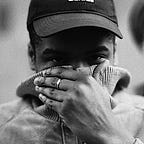What’s the Difference?
Efosa Osaghae explores the very different worlds of narrative, music video and commercial production.
At first glance, there are many similarities within the different factions of the moving image industry. Music videos, commercials, and narrative works all require the same basic elements. They require a crew, some form of a script, and a schedule. Many of these crew members overlap, working on a variety of projects across the sectors.
However, there are stark differences in the industries that many creatives don’t realise before they begin to move between projects. Exploring these differences can help young creatives find the perfect place for them in our complex industry.
Narrative
Narrative is typically seen as the holy grail of the moving image. It’s the industry that many dream of getting involved in, creating work that appears in cinemas or on TV. It’s the most expensive medium, and at the high end, budgets are in excess of $200 million dollars. But that isn’t the true expense.
Even on low budget film productions, films are expensive in terms of risk. A £20K microbudget film is extremely expensive to an indie filmmaker. This expense breeds precision and a meticulous nature for filmmaking, for films on microbudgets to huge Hollywood blockbusters— if a filmmaker wastes one shooting day, they may have lost the ability to finish the film without sourcing extra funds.
How does this affect the atmosphere? On set, there’s an extreme focus because everyone knows how critical each second is. If you like long term projects that you can sink your teeth into, feature films are your game.
Music videos
On one hand, music videos are inherently formulaic because they typically follow the structure of the song, in a way that a narrative film is not concerned with, and each music video genre has its own conventions. But it’s also the most experimental medium because you can accompany music with any conceivable visualisation.
For example, in UK grime music videos you will commonly find estate locations, video models and gritty visuals. If you’re working on a pop song, expect to see bold and colourful visual accompanied by an upbeat storyline.
There is typically less precision in these projects, because scenes can be cut if need be. The great thing (or not so great) about music videos is that the editor can really bring a music video together. They can bring it to life in ways not apparent on set.
I’ve been on sets where the footage we shot didn’t look anything like the final video. A good music video edit can turn a sub-par shot music video into a world-class one just through editing. This can be via VFX, rapid editing and many other tips and tricks.
Crew members who work within music videos tend to have a better work/life balance than feature film crew members. A music video shoots for 12 hours but there’s a lot less intensive work involved on either side of the shooting day.
Commercials
It’s not unheard of to shoot for 12 hours in one day, for 15 seconds of footage. Some of the most creative works on television have been commercials. They can creatively find ways to influence audiences to buy products they would never have considered otherwise.
But commercials are about one thing fundamentally.
Precision. Precision. And more Precision.
Time really is money on a commercial set. Every single millisecond of time is being tracked from multiple sources; The agency. The production company. The client.
Money is the most important element of these kinds of production. Moreso than music videos and feature films, these kinds of productions can sometimes feel like they’re run by committees rather than a few dedicated professionals. Because of the number of people who have editorial autonomy over the content, there are times where it may even be hard to spot who the director is on set!
If you’re supremely organised and like a more corporate environment then you’ll have a lot of fun with commercials.
— —
Overall, the differences between the three types of content that dominate the moving image industry are mainly found in between the lines. It’s the nuances that make each set feel different. As visual media continues to dominate society more with each and every passing year, we are seeing many of these different industries overlap. We now see music videos that are films and films that are commercials.
As the media continues to progress, the only trajectory I see is even more synergies between the mediums.
